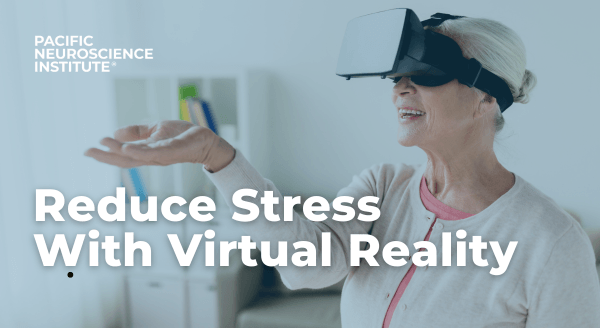

Virtual Reality Exercise May Help Lower Stress Levels
by Guest Author
Looking for ways to reduce stress levels? Immersive virtual reality exercise may just be the answer. Join Senior Brain Health Trainer and FitBrain℠ Director, Ryan Glatt, CPT, as he breaks down the latest research.
Key Takeaways
- Immersive virtual reality exercise may help lower stress levels.
- Virtual reality exercise also has physical benefits and can help stroke patients work on building balance.
- Watching a workout is not a replacement for physical activity.
The benefits of physical exercise are long-known and far-reaching. A workout at the gym or a brisk walk can keep your sharp mentally, help you maintain a healthy weight, and build up muscle.1
But if you can’t physically work out, or mobility is an issue, you may still be able to get some of those exercise benefits.

Researchers from Tohoku University’s Smart-Aging Research Center found that when people watched exercise in an immersive virtual reality setting, they got some of the same results as people who physically exercise.2
“This study showed that when individuals sat down in the real world but had a virtual avatar that was running from the first-person perspective, that individuals had less anxiety and a decrease in the concentration of a salivary biomarker that is associated with stress,” explains Ryan Glatt, CPT, NBC-HWC, a personal trainer and brain health coach for the Pacific Neuroscience Institute at Providence Saint John’s Health Center, who was not involved in the study.
While it’s not the same as actually getting your body in motion, virtual reality exercise may be the next best thing. We take a look at the research behind the experience, some of the benefits and drawbacks of immersive virtual reality exercise, and who can benefit from it.
What the Research Says
Over 50 volunteers in Japan took part in this recent study. Before each of their two sessions, the participants answered questions about feelings of stress and anxiety. In addition, researchers used disposable strips to collect samples of salivary alpha-amylase, an enzyme that is a biomarker for determining levels of stress.
Individuals then took part in an immersive virtual reality (IVR) exercise training. IVR makes the user feel like they are a part of an experience, with a headset that transports them virtually into the scene they are watching.
For this study, participants wore an IVR visor and watched an avatar run for 30 minutes at a speed of 6.4 kilometers per hour. After the session, participants completed another questionnaire and had their stress levels monitored again.
The findings, published in International Journal of Environmental Research and Public Health, showed there was some benefit to watching the exercise on screen.

After watching the avatar run for half an hour, researchers saw a reduction in the concentration of salivary alpha-amylase.2
Healthy subjects that watched the avatar run for 30 minutes from the first person point of view experienced decreased anxiety. These results present numerous potential clinical implications. Anxiety is one of the most frequently reported symptoms among the general populace.
It’s interesting to note that the decreased anxiety levels happened when the study participants watched their own avatar exercise. When they watched another virtual body run, there were different results.2
“According to the researchers, there seems to be a psychological sense of ownership over a virtual body in a first-person perspective, whereas the benefits were not detected in a third-person perspective,” explains Glatt.
Researchers note that this is the first time that a study looked at a person’s stress levels as they used their own virtual body to exercise.2
Though the study sample size is small, it is a promising look at another potential benefit of taking part in an IVR exercise experience.
Virtual Reality Benefits and Drawbacks

Virtual reality (VR) is a steadily growing technology. There are over 171 million VR users worldwide.3
Most people are likely familiar with using virtual reality for video games. However, it’s also used in the education, manufacturing, and healthcare sectors.4
As this study shows, VR is useful in the health and wellness arena. The latest findings build upon other research focused on using VR exercise experiences.
A 2016 study showed that virtual reality helped stroke patients improve their balance.5 Another 2016 study looked at a mental health application for VR, finding that it helped in psychological treatment.6
Similarly, this latest study found movement-related benefits without the necessity of being in motion. That type of application could benefit people for whom movement is a challenge.
Individuals who are mobility-impaired or paralyzed may be able to benefit psychologically from the simulation of moving or running in a first-person view.
Ryan Glatt, CPT
“Perhaps individuals in office settings may want to feel better without exercising to boost their mood or reduce anxiety, and can simulate exercise without doing it,” states Glatt.
While Glatt does note that more research is required to determine true benefits to these groups, this latest study makes it a viable option. But there are concerns with the experience.
“There could be several drawbacks to simulated, immersive, virtual movement. The main one being that performing simulated exercise instead of actual exercise leaves many health benefits to be desired by engaging in sedentary virtual simulations,” Glatt says.
Experts note there is also the risk of the virtual movements leading to motion sickness.7 Wearing the headset for extended periods of time can result in neck injuries and even spinal trauma.8 And unfortunately, you don’t build upon proper exercise techniques.
Cost is another consideration. VR equipment may be expensive, while going for a walk is free.
Is It for You?
IVR brings an interesting dimension to exercise. It sounds fun and is even beneficial. But is it for you? If you can’t seem to make it to the gym, should you just throw on a headset and enter another realm?
“For those who have a hard time getting motivated to exercise or have specific psychological aversions to exercise, these types of simulations may be helpful in ‘simulated exposure therapy’ prior to engaging in actual exercise,” Glatt says.
But even with all of the benefits, experts are not saying to cast caution to the wind and forget exercise. Indeed, something is better than nothing, but it’s important to put it in perspective. Watching an individual perform exercise does not replace the benefits of moving your own body.
What This Means For You
Immersive virtual reality exercise is a mentally engaging way to keep active. As the study shows, you can still receive mental health benefits, similar to those you get from physically working out. While more research is needed, the practice may be beneficial and worth exploring if movement is an issue. It is not meant, however, to be a replacement for getting up and moving your body.
Adapted from the original article in Very Well Mind.
Optimize Your Brain Health Today

Discover science-based strategies to enhance cognitive fitness with the Lifestyle Program at Pacific Neuroscience Institute. Our expert brain health trainers address five key areas of focus to support your brain health:
- Optimize memory
- Improve nutrition
- Reduce stress
- Upgrade fitness
- Regulate sleep
How to Enroll in the Lifestyle Program
Offered in group or individual sessions, as well as both virtually or in-person, Lifestyle courses are truly made for everyone. If you or a loved one are ready to transform your lifestyle, click here to sign up, or call 213-344-2037.
1301 20th Street, Santa Monica, CA 90404
213-344-2037 / voicemail
Useful Links
- Lifestyle Program
- Pacific Brain Health Center
- Alzheimer’s Disease
- Dementia
- Mild Cognitive Impairment
- Stroke
Sources
- Centers for Disease Control and Prevention. Benefits of physical activity.
- Burin D, Cavanna G, Rabellino D, Kotozaki Y, Kawashima R. Neuroendocrine response and state anxiety due to psychosocial stress decrease after a training with subject’s own (but not another) virtual body: An RCT study. Int J Environ Res Public Health. 2022;19(10):6340. doi:10.3390/ijerph19106340
- Zippia. 23 amazing virtual reality statistics [2022]: The future of VR + AR.
- Statista. Virtual reality (VR) – statistics & facts.
- Li Z, Han XG, Sheng J, Ma SJ. Virtual reality for improving balance in patients after stroke: A systematic review and meta-analysis. Clin Rehabil. 2016;30(5):432-440. doi:10.1177/0269215515593611
- Valmaggia LR, Latif L, Kempton MJ, Rus-Calafell M. Virtual reality in the psychological treatment for mental health problems: [A] systematic review of recent evidence. Psychiatry Res. 2016;236:189-195. doi:10.1016/j.psychres.2016.01.015
- Park S, Lee G. Full-immersion virtual reality: Adverse effects related to static balance. Neuroscience Letters. 2020;733:134974. doi:10.1016/j.neulet.2020.134974
- Baur C, Pfeifle C, Heyde CE. Cervical spine surgery after virtual reality gaming: A case report. J Med Case Reports. 2021;15(1):312. doi:10.1186/s13256-021-02880-9
Related Articles
Last updated: November 6th, 2024



